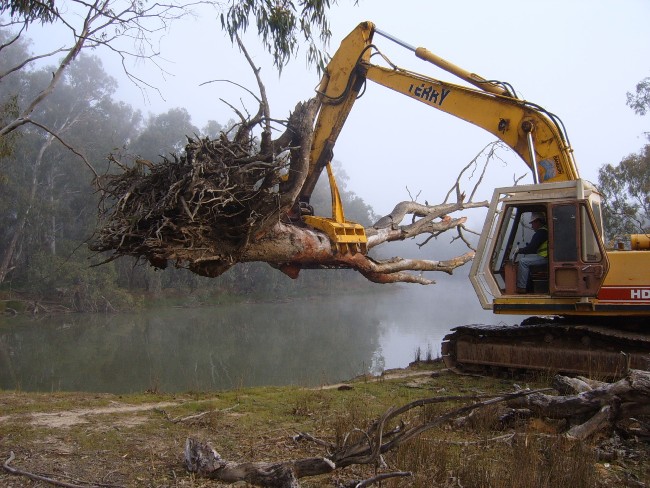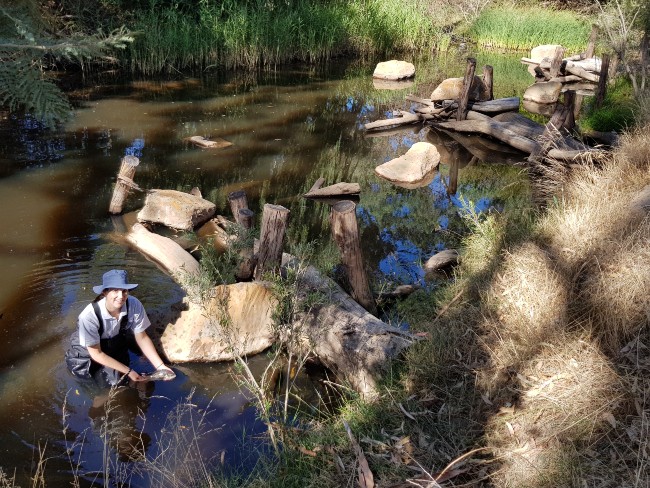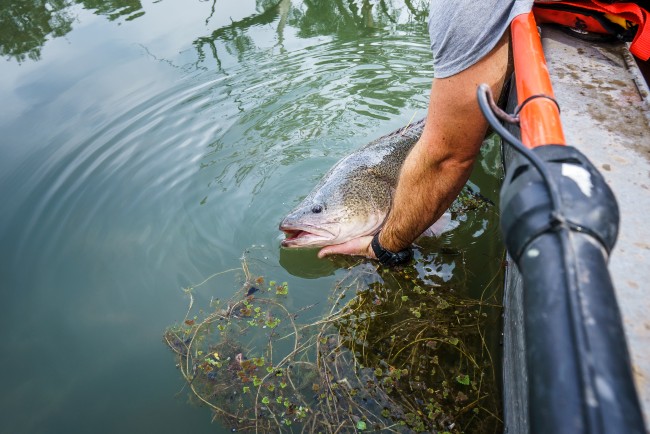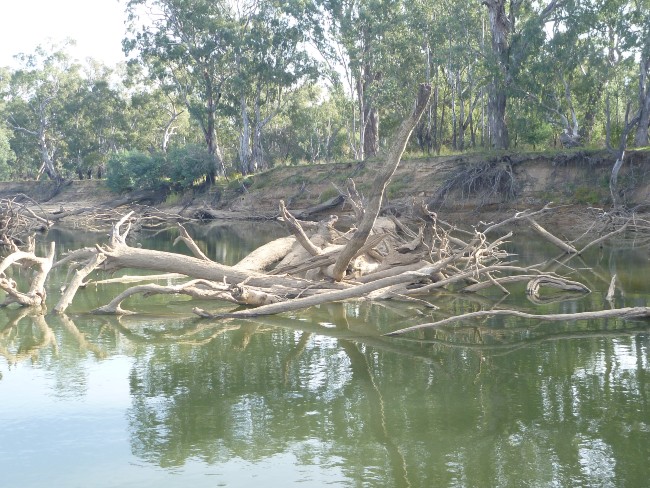Snags for healthy waterways
Instream woody habitat (IWH), commonly referred to as 'snags', consists of trees, branches and logs that fall or are washed into rivers and streams. IWH has a range of functions essential for maintaining the health of a waterway, and in turn supports recreational fisheries and other social and cultural values.
IWH is important for fish; it provides food resources, refuge from competitors and predators, spawning habitat and shelter from flowing water. The removal of IWH has been a major factor in the decline of many freshwater fish populations.
In the past, IWH was removed from many Victorian rivers to make boat travel easier, protect properties and infrastructure, and in response to beliefs about reducing flooding. Research has since shown that IWH has little effect on flooding and removing it can reduce riverbank stability. River restoration programs now often include the reintroduction of IWH.
This page highlights some of ARI’s work on IWH. Much of this research has been funded by DEECA Water and Catchments and focuses on understanding:
- the status of IWH within Victoria rivers
- the links between IWH densities and native fish populations, and
- how to support improved planning and evaluation of IWH interventions.
What we are doing
ARI undertook a long-term project to assess the importance of IWH for fish and river health. This included state-wide mapping of existing IWH and predictions of natural IWH over almost 27,770 km of rivers, and quantifying links between habitat and important fish populations to help guide IWH restoration. This mapping project found:
- On average, current IWH densities were 41% below estimates of natural historic levels
- Nearly 17,000 km (62%) of rivers had IWH densities severely (80% below natural historic levels) or highly depleted (60% below natural levels).
The mapping project has greatly improved our ability to quantify IWH densities relative to historical conditions and, importantly, helped guide restoration by prioritising sites and setting targets.




RiverRehab decision support tool
This information was used to develop the ‘RiverRehab decision support tool’ to help waterway managers identify suitable reaches for instream habitat protection or addition. The tool incorporates riverside attributes, aquatic fauna occupancy, and hydrology information. Users can calculate a habitat ‘suitability’ index and identify reaches that may benefit from rehabilitation. These attributes can be modified depending upon the objectives and priorities managers may have for different sites. The tool helps waterway managers prioritise sites to protect or rehabilitate instream habitat according to their objectives.
- Riverine rehabilitation decision support tool (PDF, 454.1 KB) (accessible version (DOCX, 3.7 MB))
Linking IWH densities and native fish populations
ARI has conducted several large-scale monitoring projects to investigate the connections between IWH and fish and to support river rehabilitation.
Links between IWH and six fish species of ecological, recreational, and cultural significance were explored at 335 sites across eight streams in south-eastern Australia. This work found strong associations between fish abundance and IWH density, with the strength of this relationship varying between species and waterways. Murray Cod showed the strongest association with IWH density, with significant associations also found for River Blackfish in particular waterways. These findings can help guide waterway restoration efforts, including to provide a framework to predict how fish may respond to IWH interventions.
ARI also conducted a seven-year monitoring program (2007-2013) to assess the effectiveness of a large-scale project to restore IWH in the Murray River between Lake Hume and Lake Mulwala. The study, as part of The Living Murray program, found that the restoration efforts enhanced native fish populations within the Murray River.
Working together to repurpose timber
Timber felled during road projects can be used for waterway rehabilitation. In 2019, a Memorandum of Understanding for repurposing timber felled during road projects for waterway rehabilitation was signed by 14 Parties. Signatories included the Roads Corporation (VicRoads), Major Road Projects Victoria, DELWP, the Victorian Fisheries Authority, all Victorian catchment management authorities and Melbourne Water. The partnership of state authorities which manage roads, catchments, waterways, biodiversity and fisheries enables timber removed through road projects to be used for waterway rehabilitation. To support this partnership, Timber for fish: Repurposing timber (removed from road projects) for waterway rehabilitation guidelines (PDF, 11.5 MB) (accessible version (DOCX, 3.7 MB) have now been developed. These guidelines aim to support VicRoads and Major Roads Project Victoria staff when giving management advice to road contractors. They provide relevant information about the importance of timber for waterway health and fish; the history of timber removal from waterways; timber requirements for waterway rehabilitation; and the steps to follow when reinstating timber into waterways.
Incorporating research into river rehabilitation programs
In recent years, there has been substantial investment in reinstating IWH in Victoria. There has, however, been limited recording of these actions, benchmark setting or comprehensive monitoring to assess the rehabilitation works and outcomes for fish. In addition to the aforementioned work, ARI has undertaken an overview of instream habitat interventions across Victoria, including the collation of data, benchmark guidance and evaluation. This information, along with current conditions and quantitative links with native fish populations is also being incorporated into other projects and analyses such as population modelling, used to assess threatened species recovery to management actions.
For more information contact: zeb.tonkin@deeca.vic.gov.au
Publications
The following journal articles are related to ARI’s work on instream woody habitat:
- Tonkin, Z., Kitchingman, A., Fanson, B., Lyon, J., Ayres, R., Sharley, J., Koster, W., O’Mahony, J., Hackett, G., Reich, P. and Hale, R. (2020). Quantifying links between instream woody habitat and freshwater fish species in south-eastern Australia to inform waterway restoration. Aquatic Conservation Marine and Freshwater Ecosystems 30:1385–1396.
- Tonkin, Z., Kitchingman, A., Ayres, R.M., Lyon, J., Rutherfurd, I.D., Stout, J.C. and Wilson, P. (2016) Assessing the distribution and changes of instream woody habitat in south-eastern Australian rivers. River Research and Applications 32: 1576–1586
- Kitchingman, A., Tonkin, Z., Ayres, R.M., Lyon, J., Stout, J.C., Rutherfurd, I.D. and Wilson, P. (2016) Predicting natural instream woody-habitat loads across large river networks. Marine and Freshwater Research 67(12): 1844-1852
- Kitchingman, A., Tonkin, Z. and Lyon, J. (2013) A novel approach to spatially assessing instream woody habitat densities across large areas. Journal of Environmental Management 128: 555-56
Page last updated: 28/03/25